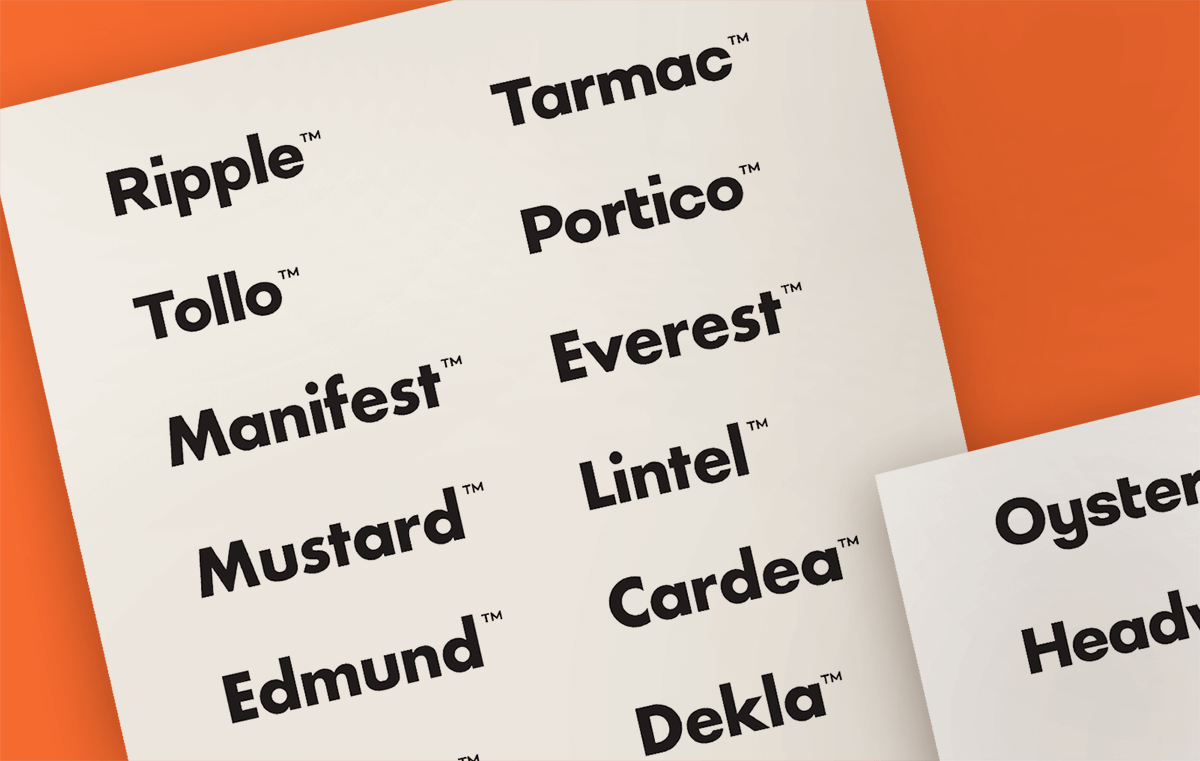
Sometimes you hear a business name that’s so good, it sticks with you. Years ago I stumbled on a small shop in Portland called Noun: A Person’s Place for Things. I don’t remember much about the pretty things in the store. Just the name, which delighted me. When I was a kid on vacation with my family, a guy on the lake had a fishing boat named the Lip Ripper. Ew! It lives on in my mind. Not every business or product name has to be so catchy. Some of the most successful companies have very utilitarian names. But every entrepreneur wants a name they can stand behind proudly. When you love your brand, your confidence will make promoting it easier. If you’re wondering how to choose a business name thoughtfully, read on.
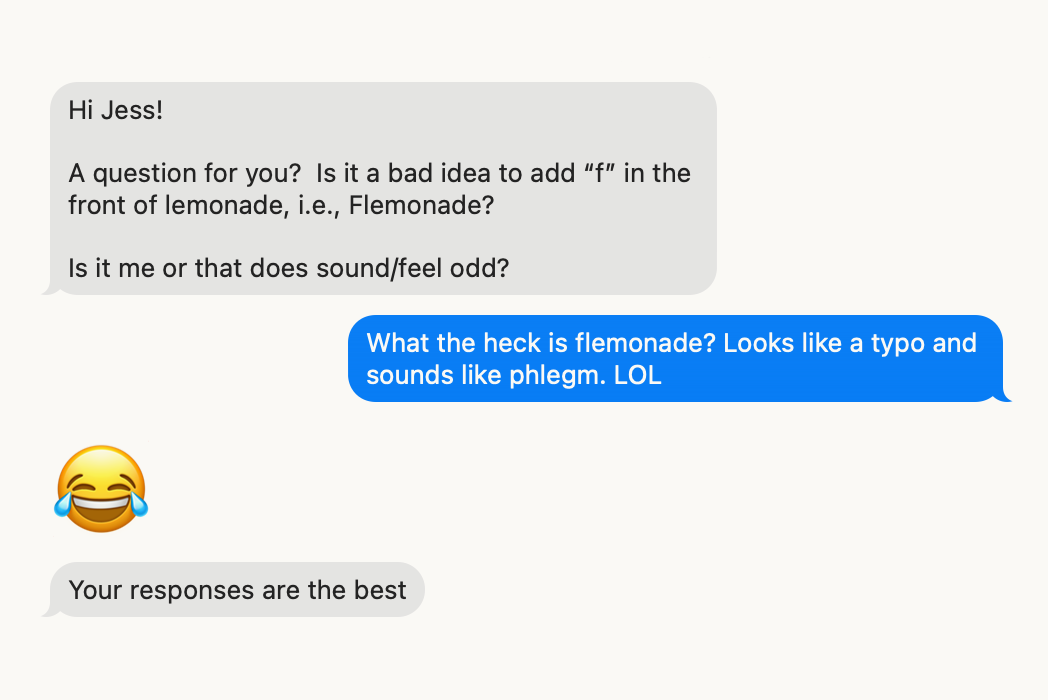
The other day a good friend texted me out of the blue:
“Is it a bad idea to add “F” in front of lemonade, i.e., Flemonade? Is it me or does that sound/feel odd?”
Once I realized he was trying to name a company, my reaction was instant:
That is odd, and not in a good way.
Later he asked what I thought of misspelled business names, like Flickr or Fiverr. I don’t love them. More on why in a minute.
But I empathize with the struggle. Naming is haaaard. All the good names are taken!
But wait. Are all the good business names taken? There are more than one million words in the English language. And they can be combined in different ways, either in their entirety or in parts, or you can even make up words that “sound right” based on linguistic principles most of us don’t even notice. Naming is a word puzzle that can have satisfying solutions.
Professional firms who specialize in business naming will charge tens of thousands to handle this process for you, because it’s hard, and it’s invaluable. Many small businesses starting out don’t have that kind of budget. So if you want to DIY it, follow the steps in this mini guide to company naming.
Steps in a nutshell
1. Decide what the business name should convey
2. Consider categories of names to explore
3. Brainstorm business name ideas
4. Test your favorite name ideas
1. Decide what the business name should convey
Before you dive into brainstorming, establish some direction. Ask yourself:
What are some distinctive qualities of your business or product?
Obviously your company does something or sells something, so you’re aware of what you’re naming. It’s an energy drink or a marketing firm, for example.
But besides that, what qualities does this business or product have? List some traits. For example: future-focused, super durable, unusually creative, unconventional, cerebral, uncommonly kind, relies on a long tradition, strives for perfection, has a certain geographical location, is very creamy, moves fast, has German origins… you get the idea. List any traits you can think of.
How should the name sound?
Perhaps powerful, or relaxing, no-frills practical, premium, spicy, or humorous. Jot down a few adjectives.
Who should the name resonate with?
A certain age group, gender, ethnicity, profession, people with particular interests or feelings. Maybe it’s people with aging parents, or new dog owners, blue-collar workers, stressed-out people with no time, marketing departments, hedge fund managers, or whatever. Keep your audience in mind, not just your own team. They may be different.
In what geographic region will this brand exist?
Maybe you already know it will remain a local business. Maybe you hope to scale regionally, nationally, or internationally. A small town plumber will have fewer concerns than a globally-sold salty snack, which will need language screening to make sure the name doesn’t accidentally mean boobs in Mandarin. Two similar businesses with the same name in two different states may not face much legal risk if neither plans to expand to the other’s location (avoiding customer confusion). But a national brand will need more screening. Be mindful of your business goals when naming, either to possibly reference the location in the name, or for getting legal clearances.
Is there anything to avoid when choosing the name?
Think of your immediate competitors. If their names all fit a certain mold (tech startups that end in “ify” or “ly,” car models with animal names, consultancies using initials, or boutiques called noun & noun) you may want to go a different direction to stand out. Or maybe you suspect your products or services will shift over time. In that case, you might want to avoid pigeon-holing yourself with an overly descriptive name. On the other hand, maybe descriptive is exactly what you need, if you don’t want to work hard to market an unusual, abstract name.
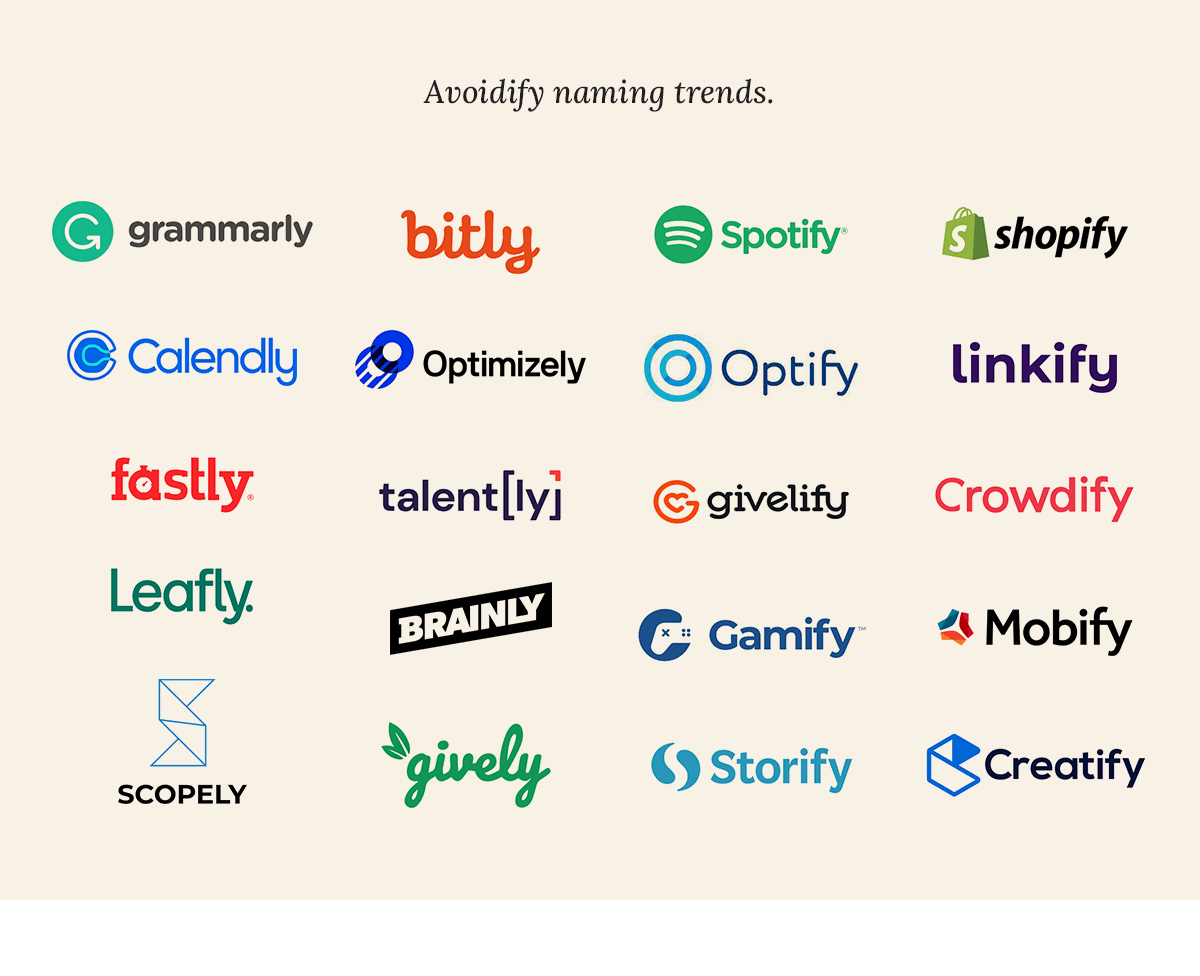
2. Consider categories of business names to explore
For inspiration, it’s helpful to be aware of different types of company names. You can choose some to focus on, and rule out others that don’t seem appealing. If you’re not sure which category is best, brainstorm a few initial names in every category. See which direction you prefer. Then dive deeper into your favorite.
Experts divide names into lots of different categories and differ on what those categories should be… uh… named. To keep it super basic, here are some categories to consider when choosing a business name.
Construction of the name
Most brand names fall into three categories based on how they’re built.
Real words
These are words that exist in languages already: Amazon, Taco Bell, Oracle, The New York Times, Twitter, Philip Morris, Peloton.
Real-word names could be from other languages like Latin or Swedish. They could be characters from mythology, or founder names, or terms from basket weaving.
Compound words
These are stuck-together real words that aren’t normally joined: Dropbox, Fitbit, PayPal, YouTube, FedEx.
Made-up words
These are invented words: Pixar, Kleenex, Verizon, Xerox, Accenture, Kodak.
These can be misspellings, shortenings, or mash-ups of partial words. Many have at least some connection to real words. Accenture is an abbreviation of “accent on the future.” Xerox is a made-up word meaning “dry writing,” from the Greek xero (dry) and graphy (write). Latin prefixes and suffixes can come in handy in this category.
The sound of an invented word can hold meaning, too. In a famous experiment, people are shown a rounded amoeba shape and a pointy, star-like shape. They’re offered two names: Kiki and Bouba. Participants are asked to assign one name to each shape. Overwhelmingly, people across the world name the spiky shape Kiki and the blob shape Bouba. Humans are used to associating sounds with meanings, and it works in naming. If you’re coining a new word, trust your instincts. A nonsense word might “sound” big, small, fast, slow, bright, dark, fancy, rugged, male or female. If it just “sounds right” to you, it will probably sound right to other people, too.
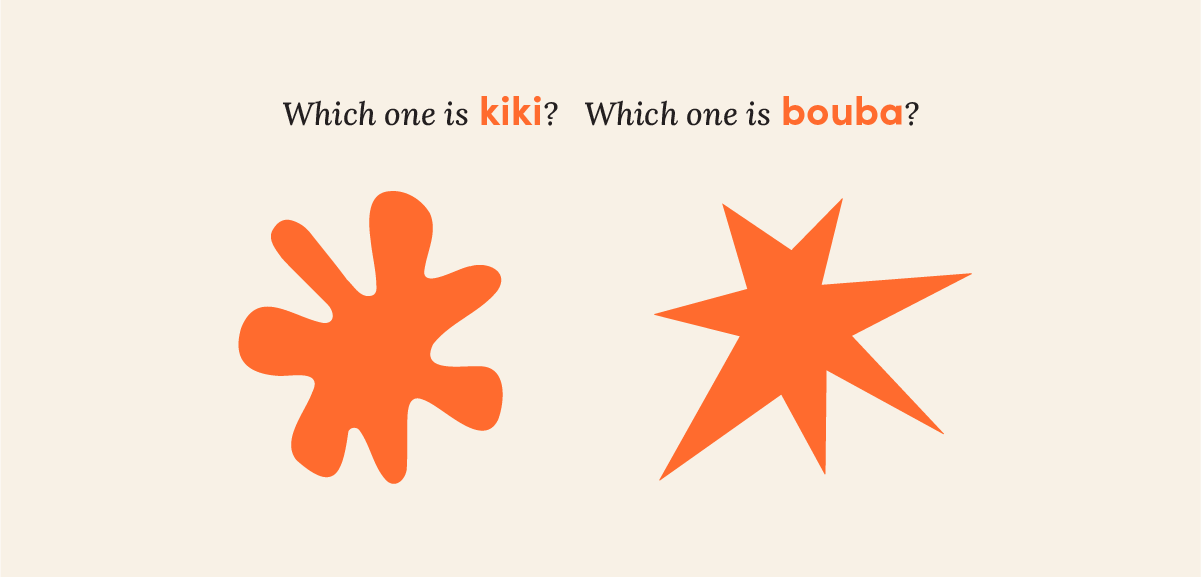
Style of the name
Besides how a name is constructed, consider its style. The line between these can be fuzzy, but it’s helpful to think about two approaches when choosing a business name.
Descriptive
These names describe a business, product, or service in a literal way. They reference what the business does, sometimes adding a founder’s name or a geographic origin. The Container Store. The Weather Channel. Hotels.com. Mike’s Carwash. Kentucky Fried Chicken. Bank of America.
On the plus side, these are straight-forward and clear. They can help you seem trustworthy, because what you see is what you get. The down side is they don’t offer any hints about your brand personality. They don’t have a story or emotion embedded in them. This may be a missed opportunity to create a stronger connection with your audience. These can also be harder to trademark.
Creative
This category is suggestive, metaphorical, or arbitrary. Nike, the goddess of victory. Twitter, the sound of birds talking to each other in short chirps. Bluetooth was a king who united Scandinavia. Swiffer is a made-up word, but it sounds like it should mean swishing the dust off of surfaces.
Creative names have the potential for greater impact. They can trigger emotions and mental pictures. They prompt the audience to search for meaning, and when they discover it, it feels satisfying. Subconsciously, customers transfer this happy feeling to your product. The downside is these names can be confusing or misinterpreted. (Apple makes… phones?) But creative names are usually more memorable. They imply that your brand is more than simply your product or service. There’s a story behind it.
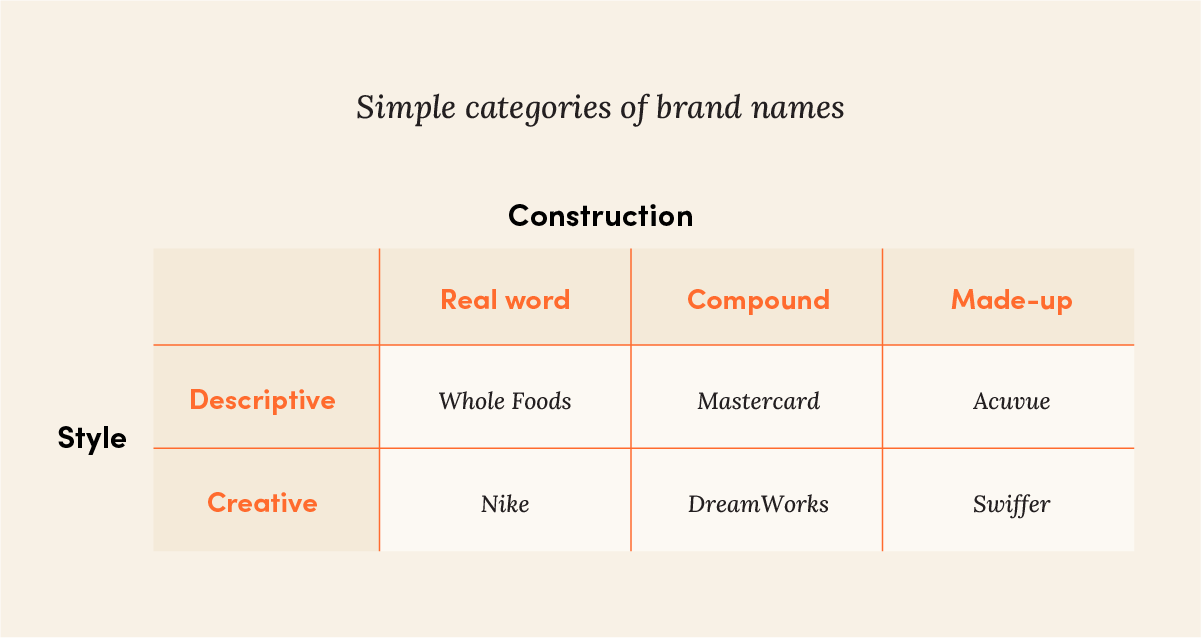
Two types of business names you should probably skip
In my work as a visual identity designer, I see a lot of brand names. There are two common types of company names that bum me out when I need to work with them. Not saying you can’t use these styles! Just be sure to consider the downsides first.
Initialisms
This is a group of all-caps letters pronounced individually. You see it all the time. Business consultants Bob Johnson, Mary Smith, and Jane Harding get together and name their new company “JSH Consulting.” It’s functional, but utterly forgettable. Yes, IBM is a household name. But only because time and money have made the brand name famous. (Until 1947 the logo spelled out “International Business Machines,” a descriptive name from yesteryear.) If you don’t have decades and millions in your marketing budget, avoid letters that will seem meaningless to the uninformed.
If you want to use initials, try to create an acronym—a set of letters pronounced as a word. NERF stands for Non Expanding Recreational Foam. NASA stands for National Aeronautics and Space Administration. GEICO is The Government Employees Insurance Company. These acronyms are easier to say and remember because they follow spelling and pronunciation rules.
Misspellings
Can a misspelled word make a good company name, like Flickr or Fiverr? A word that’s spelled wrong can seem like a good idea. It’s uniquely ownable, and often available as a domain name. However, customers don’t like misspelled names as much as correctly-spelled names. They can be seen as inauthentic and gimmicky. And you’ll need to work extra hard to educate your audience.
Entrepreneur at a party: “I just started a dog grooming company! It’s called Groomr.”
Stranger: “Cool, I have a dog. I’ll check it out. Do you have a website?”
Entrepreneur: “Yes! It’s groomr.com. Spelled like groomer, but without the E.”
I’m pretty sure you don’t want your official tagline to be “Spelled without the E.” Unless you have millions of marketing dollars, save yourself some angst. Avoid names that require a spelling lesson, especially if they use letter combinations that never appear in your native language.

3. Brainstorm business name ideas
Once you’ve pondered what the name should convey, and you have possible styles in mind, it’s brain dump time. You start a spreadsheet with a new row for every name possibility. It’s easy to cut, paste, or reorder. Or you might prefer Post-it notes or mind maps with words in circles connected by lines.
Each name can send you off in different directions as you pursue certain metaphors, styles, or combinations. Once you’ve exhausted a particular avenue, go back to the fork in the road and set off down a different path. Don’t edit as you go. Write fast, edit later.
Business name prompts to fuel your creativity
Famous stories
Search lists of fables, famous literature, plays, movies, or historical incidents that involve a certain theme (money, speed, growth, etc.), and choose a word, phrase, part of a quote, place, or person’s name from the story.
Idioms
Search for idioms and short sayings that contain a particular word or topic, like “southern sayings” or “water idioms.” Pick out words from the phrase to use, or replace one of the words with a rhyming word. For example, “many hands make light work” becomes Many Hands.
Adjectives
Add an adjective. There are many types:
Descriptive: red, simple, honest, etc.
Numeral: three, second, etc.
Quantitative: many, half, any, etc.
Interrogative: how, which, whose, etc.
Possessive: your, our, her, etc.
Extra points for alliteration—unless it sounds too flippant for your brand (Best Buy, Constant Contact, Merry Maids)
Niche vocabulary
Search for less-common words associated with an industry, trade, or subject (math terms, nautical terms, types of rocks, people on the Mayflower).
Mythological names
Search lists of mythological names and deities associated with concepts. (Roman, Greek, Mayan, Scandinavian, etc.) They might be taken in your category, but maybe not.
Word of mouth
Make a list of what people could say about your brand if they were telling a friend about it. Fill in the blank and make a name out of it: “That’s the one that is ___.” For example, “That’s the one that’s open 7 am to 11 pm: 7-Eleven. (Halfprice Books, Anytime Fitness)
Places
List place names that may be relevant, either because they’re near your location or they have the right association (Niagara, Sahara, tundra, Amazon, Midwest).
Founder
Use a founder’s name or made-up person’s name that has the right qualities (Kate Spade, Smucker’s, Chanel).
Dictionary flip
If there’s a certain sound you’re after—for example, ch, k, and f words can sound fast, while b, d, m, and n words can sound slow—go hunting in those sections.
Truncate
Drop the beginning or ending (Accurate becomes Acura).
Replace
Replace a letter or syllable, as long as the word is still spelled the way it sounds (Dictionary becomes Pictionary).
Latin parts
Search for lists of Latin roots, prefixes, or suffixes and add them onto other words or fragments.
Translate
Use a translation tool to find foreign words. Caution! Run these by a native speaker if you can, to make sure there aren’t any nuances you’re unaware of.
AI
Describe your naming challenge to ChatGPT or one of the many other AI apps and generate lists of names. Most of it will be useless, but there could be a good seed or two.
Resources to help you brainstorm brand names
- 50 Ways to Name It – a fantastic booklet by Caitlin Barrett [Update: I just found this—go get it!]
- Onelook.com — generate lists of related words, phrases and rhymes
- A reverse dictionary online or in print — search for words by their definition
- Books or Google searches for word lists you’re curious about
Set realistic expectations
Don’t expect to finish in an afternoon. Naming your business will likely need several focused sessions, plus absent-minded pondering in the shower.
Your first list of names may be useless. Most will already be taken because they’re obvious. Don’t worry! It’s part of the process. Once you’ve done a first pass, you might see ideas worth exploring in spin-off lists. And if you sleep on it, you’ll have new ideas next time. You may need hundreds of names to find something that both fits your criteria and has low legal risk.
4. Test your favorite business name ideas
Once you’ve got some good contenders, it’s time to test them. Here are some helpful questions.
Is the name easy to say?
On a night out with friends, we named our trivia team the Rural Squirrels to see if we could trip up the MC with a name that’s tough to pronounce. Sure enough, when announcing the teams, the MC stumbled over it and laughed. Success!
But unless you’re a comedian, you probably don’t want to choose a business name that’s a tongue twister. Say it out loud in sentences. “I work at X.” “They wanna buy an X.” “We hired X to do it.” Is it easy? Does it make you feel silly, or confident?
[Update: I wrote this post before Twitter was renamed X. Let’s test it: “I saw that Jessica Xed about that.” Awkward. This is why everyone still says “tweeted.”]
Would you know how to pronounce it if you saw it in writing?
Will people read the name out loud correctly? Starchive—is that “star chive” the herb, or “star kive,” a play on archive? SaYes Studio—is that “sah yes,” “say yes” or “saze”? Confusion is not a good feeling to associate with your brand.
Does it look good in print?
Type it out on a blank page. Put a ™ after it so it looks official. Visually, does it look reasonable?
Does it have a meaning in another language that is bad or doesn’t fit?
Run it through Google translate and see if anything obvious comes up. This may not matter if you’re a local small business with no desire to become a global brand. Apparently Clairol had to rename their Mist Stick because “mist” means manure in German, but that wouldn’t be a problem for many businesses.
Does a Google search show other companies using it?
Try searching for the exact name, and also parts of the name plus your industry or location. See what comes up.
Is something similar registered in the TESS database?
See if other businesses have trademarked the name you’re considering. Search the US Patent and Trademark Office’s database, TESS (Trademark Electronic Search System). This can be confusing to do, so if you don’t feel confident you’ve done it right, don’t worry. In your final step, a lawyer will check on your behalf.
Is a reasonable domain name available?
Don’t panic if your ideal domain is taken. A domain name doesn’t need to be a perfect match to the business name. Today audiences are far more likely to do a Google search than type the exact URL in the address bar. Let Google do the work of finding your site. Here are two ways to pick a domain name if your exact business name is taken.
Add another word, either before or after the business name
Options could include a clarifying word, such as your location (nyc, global, midwest, etc.), the type of product or service you offer (cafe, transport, cpa, research, tech, etc.), or your business type (inc, studio, group, firm, agency, hq, club, app, store, etc.). Or, create a phrase by adding short words like “my, hey, hi, its, stay, go, shop, think, now, choose, always, get, try, taste, etc.” in front of the business name. Add “now, fun, everywhere, experts, crew, fast, etc.” after the name. These extra words wouldn’t be in the company name or logo, but they can be used in the domain name and matching social media handles.
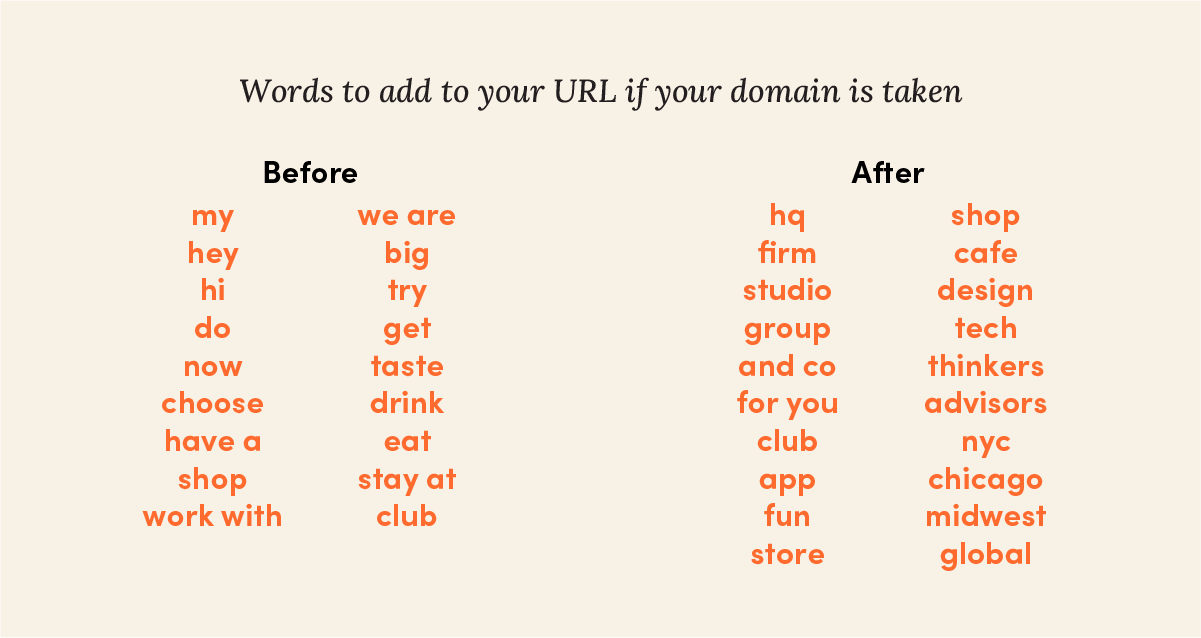
Use a top level domain (TLD) other than .com
.Net is just fine, or consider .co. Many tech startups choose .io, (input/output). Descriptive TLDs could be good choice, too (.agency, .store, life, .cooking, etc.) Here’s a list of possibilities.
As you’re considering, remember that you’ll want a matching email address, so make sure the domain will fit on a business card. Christopher@clevelandpestcontrolandlandscaping.com may struggle.
Hire a lawyer if you want to legally claim the name
Recommended!!! They’ll do a more thorough search and advise you of any risks. This helps ensure you can confidently use the name without risk of stepping on another company’s turf.
If the DIY approach fails
If you’ve given naming a go, and you still feel stuck, get in touch with a naming specialist. Your brand name is the element of your brand that you’ll keep the longest, and it’s an opportunity to create something strategic. Choose well!
More reading
Many resources from Caitlin Barrett at Naming for Everyone, Psychology of Brand Names by Nick Kolenda, Brand Naming by Rob Meyerson, Don’t Call It That by Eli Altman
